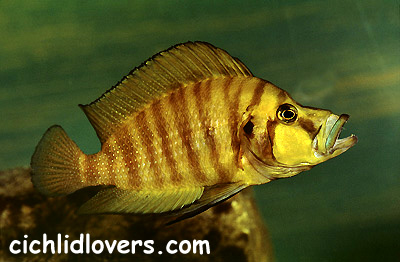|
|
||
  |
Altolamprologus compressiceps Chaitika orange
A male in the aquarium - Ad Konings
A male in the aquarium - Doug Conkling
A male in the aquarium - Alan Bliven Trade names: Orange Compressiceps Distribution: Zambia, Lake Tanganyika. Max size: Males 5", females 4". Sex differences: Males of the same age are much bigger than the females. Habitat: Rocky areas. Food: Small shrimps, crustaceans and sometimes very small fishes under 1/2 inch. Will accept dry foods but prefers live or frozen meaty foods in captivity. Behavior: They have a tall and very laterally compressed body which lets them go into narrow cracks in the rocks, turning their bodies at all angles. They cruise over the bottom looking for prey; once prey is located they will stop and tilt their bodies head down, ready to strike from a short distance. They also will do this in the aquarium; hold the eye stationary and move the head and body at all angles. The "Altolamps" may look very aggressive but being so laterally compressed are not built to do battle with other cichlids. Maintenance: Not aggressive to other fishes but can get aggressive to each other. Best kept in in a 4'+ long tank with a lot of large rocks and caves. Can be kept with almost any other Cichlid or even common community fish. But will sit in the middle of a mouthbrooder's nest and steal the eggs; will also steal eggs and fry from substrate breeders. They have armored scales for protection. They will bend their bodies exposing the armored sides to an enemy; many times the enemy will bite on the armored scales until their lips are frayed. These armored scales may also help protect them from losing scales in the wild as they move in and out of narrow cracks in the rocks. Breeding: Substrate breeder; female breeds in a cave to small for the male to enter. Forms loose pair bonds, hard to keep one pair solitary. Many times polygamous; males seem to prefer one female over others but will raise families with multiple females at one time. Best to use "spawning caves" or sea snail shells big enough for the female but to big for the male. The male doesn't need to get in the cave to fertilize the eggs, he releases his milt at the entrance and the pair fans their fins to get it inside on the eggs. Spawns of 100-200 are not uncommon. The fry are not cared for outside the cave in which they are spawned in. Once free swimming the fry wander off on their own. They are very slow developing and growing fry; takes up to 6 months to reach 1.5" and 2.5 years for sexual maturity to be obtained. Comments: The "Orange Compressiceps" is one of the most colorful Altolamprologus. Home Availability List |
        |
|
Banner is of Malawi National Park by Pam Chin |
||
